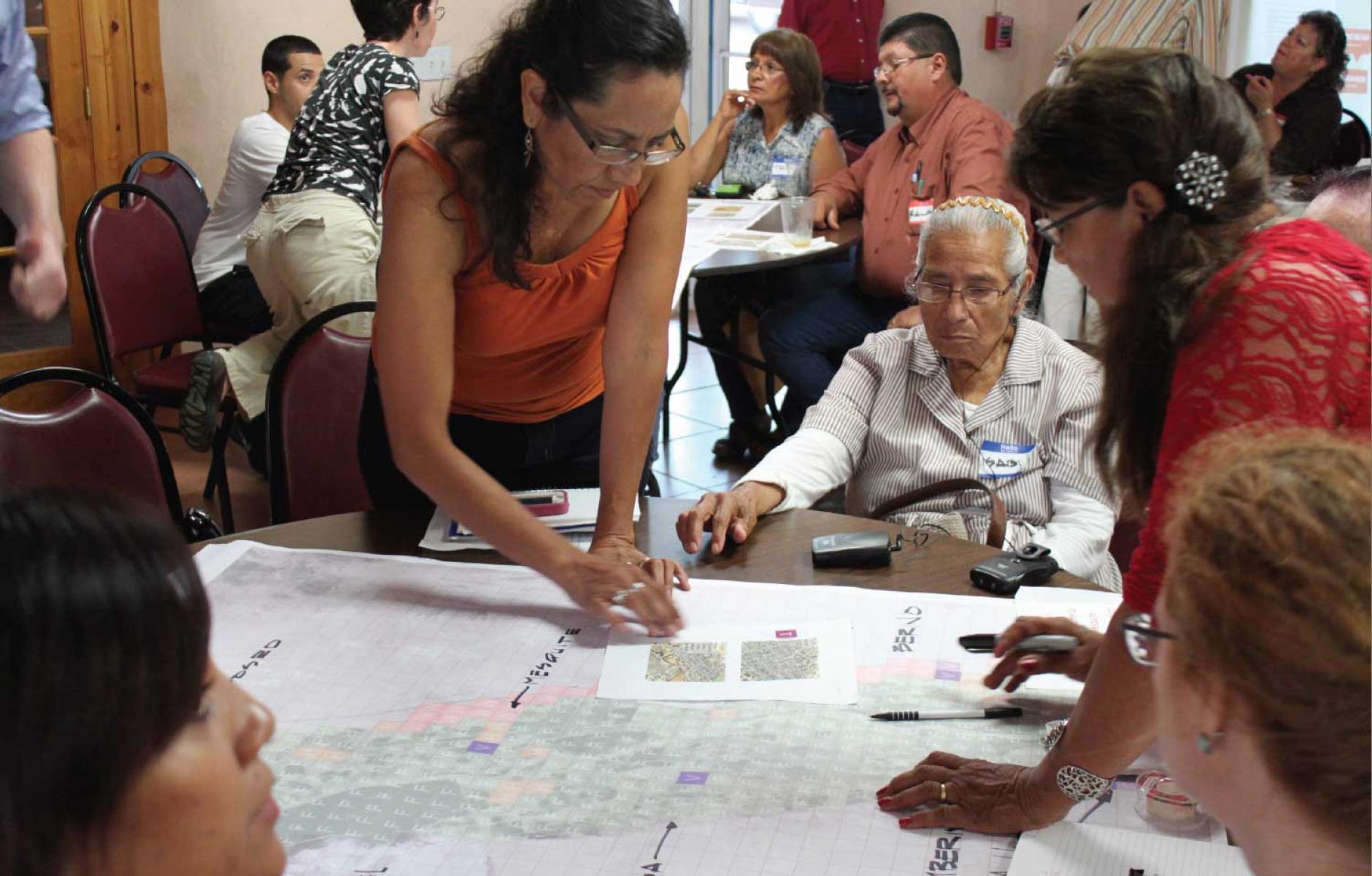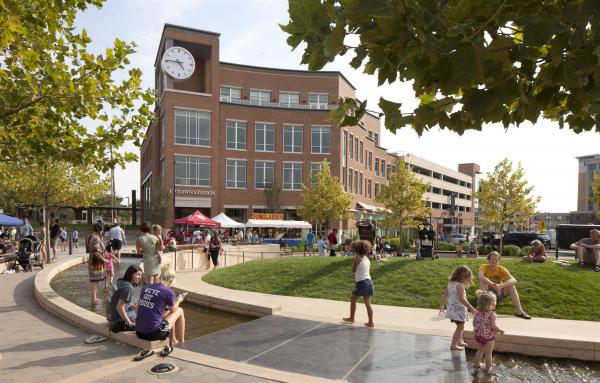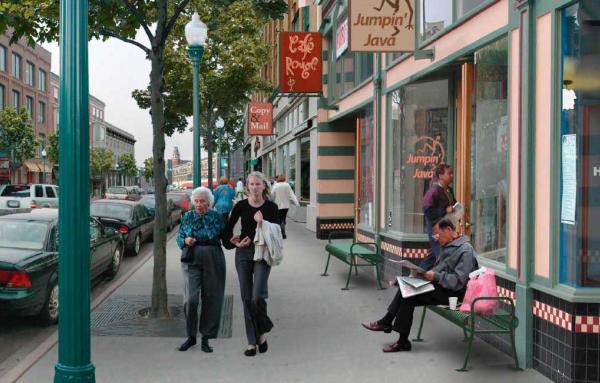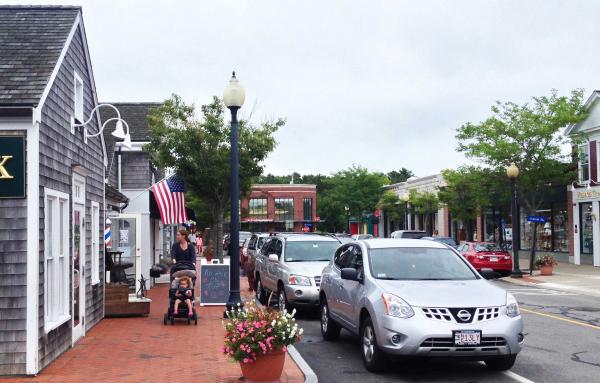
Great idea: Multidisciplinary design charrette
In celebration of the upcoming CNU 25.Seattle, Public Square is running the series 25 Great Ideas of the New Urbanism. These ideas have been shaped by new urbanists and continue to influence cities, towns, and suburbs. The series is meant to inspire and challenge those working toward complete communities in the next quarter century.
To plan complete neighborhoods instead of single-use subdivisions and shopping centers requires a holistic public process. Many disciplines such as traffic engineers, market and financial analysts, architects, urban designers, and planners need to work together with citizens, elected officials, business owners and other stakeholders. The multi-disciplinary design charrette—often used for infill and transit-oriented neighborhoods, complete streets, form-based codes, and city plans—will play a key role in the movement toward complete communities.
Public Square editor Robert Steuteville interviewed Bill Lennertz, founder and faculty member of the National Charrette Institute and principal of Collaborative Design and Innovation, and Jennifer Hurley, principal of Hurley-Franks & Associates, on the subject of charrettes and how they contribute to holistic communities.

How do you define charrette? Because people are using the term in all sorts of ways today.
Lennertz: Speaking as a faculty member of the National Charrette Institute, and speaking as someone who was there at the 1988 DPZ charrette—which, if it wasn't the first, it's one of the first multiple-day charrettes that involved communities—my definition of a charrette is a multiple-day process that engages all affected parties to create a transformative plan that can get built. And there's also the aspect of time compression—innovation occurs under pressure.
Hurley: It's a multi-day, multi-disciplinary, multi-stakeholder, on-site design workshop. I think exactly how you define each of those terms can change to accommodate something shorter than a full week or longer. But there has to be time for multiple feedback loops. It has to be multi-disciplinary. It has to get beyond concept work into something more detailed.
Charrettes have been part of the New Urbanism, almost from the very start. Urbanists were instrumental in developing the concept of charrettes, as the term is currently understood. So please tell me a little about the history and why they are so important to the New Urbanism.
Lennertz: I know the history because I was there. Some designers and architects were on to something like this as early as the 1940s. They were designers, all of them, who recognized that when they had a really big project with a lot of stakeholders, they wanted to find some way of embedding them in the design process. So there's a series of firms like UDA, CRS, Centerbrook, and Ball State University who did this. But Duany Plater-Zyberk did one in Texas, which was probably the first of what's been known as the form that a lot of new urbanist then took on—and if not in total practice today—it became known as the new urbanist charrette.
Hurley: When I first was really digging into charrettes as a practice and trying to compare them to what I knew from public policy dispute resolution and deliberative democracy engagement methods, one of the things I thought was really interesting, when I talked to folks, like Andres [Duany], and a few other people who were involved in very early charrettes, was that the motivation was at least as much about project management, and the multidisciplinary nature of design work, and trying to get all of those different silos [government agencies, engineers, architects] to work together, as it was about public engagement and public outreach.
Lennertz: I remember Andres called me up and said "I'm tired of these projects lasting so long. Let's go down and get it done right the first time." The charge is to reduce the rework. And when you start with reducing the rework, then suddenly you've got to figure out collaboration, silo-busting, all of that.
Can you talk a little bit about why this is so important to the New Urbanism, and what it really means to people?
Hurley: Well, I think it's so important because the New Urbanism itself is holistic, and so many of the things that we're trying to do have been undermined by a very narrow-minded specialist mentality. Whether it's a neighborhood NIMBY activist who only cares about whether they have a parking spot or not, or whether it's a storm water engineer who only cares about how much water they can keep on the site, we're fighting against that mentality that you can optimize for one thing. Urbanism only works if you're addressing a place holistically.
Lennertz: I think you've got it right on there. New urbanists are about transformation. Charrettes, if you do them especially more than once in one community, begin to change the way people work together and develop trust in government, in each other, in process.
I heard it said that new urbanism is both bottom-up and top-down in terms of planning trend. And I think the charrettes are the bottom-up part of that. Have you heard that? Do you know what it means?
Hurley: I actually disagree. I think charrettes are both bottom-up and top-down themselves. They're bottom-up in a sense that they're trying to engage all of the stakeholders. Everyone who would be affected. Everyone who has an influence over what happens. But they are not bottom-up in the sense of being driven by the people. They are carefully designed. The events themselves are carefully designed and structured. In that sense, they are also top-down.
Lennertz: I completely agree. Bottom up is a popular term these days. And the best charrettes are those in which the design team and the sponsor are interested in developing empathy for the people who will live with the outcome. But inevitably, decisions are being made. There is an entrusted design team. It's not like you hand the pencil to the community and say, "Just draw whatever you want and we'll make it happen." You entrust people with their specialties and their roles. I would say it's more of an organization where the best ideas are recognized and run with.
Would you say that there is any tension between the bottom up and top down aspects to a charrette?
Lennertz: There's plenty of tension in charrettes, and that's part of the creative process. It comes out of the friction that occurs when you start breaking down the silos, and putting people together to solve a problem. There's conflict. We call it the opportunity of conflict. Designers recognize the value of conflict as the source of innovation.
Hurley: I think there is some tension in that balance between participation and inclusion versus the designer's role and control of the process and the decision-making. And that's part of the variation in how different people conduct charrettes. Different firms have different approaches, and some are much more participatory. And others are more tilted towards the design end. The more you recruit a diverse representative group of people to participate in the charrette, the more that bottom-up part can be really effective. But that doesn't just happen by itself. You have to really work at it. And if you don't do that pre-work to recruit that group, you'll inevitably fall back on relying more on the designers to drive things because you won't have an effective public group participating.
There's a social equity moral responsibility there, but also a very practical aspect in that a project that's designed by the technical experts but doesn't get all the feedback of the community is far less likely to be built, correct?
Hurley: Absolutely. It's an issue of whether or not the designers have the right information. If you don't get all the right people there, you may not learn everything you need to be able to create the best design. But even if you did, even if you were an all-knowing, omniscient designer and you were able to create the best design, if you don't get enough of the right people involved along the way, you may not have enough support even if you came up with the best solution.
Lennertz: Yeah, at NCI we call it pre-charrette process-- getting ready in terms of the stakeholder identification, outreach and engagement and especially social equity. And that can be resource intensive and one of the big challenges.
So, part of the problem is resources to do charrettes, but my sense is that people are figuring out how to do charrettes for a less expensive price point than they were 10 or 15 years ago. Is that your sense as well and is that an important factor for many communities?
Lennertz: We're working on different forms of the charrette the shortest one we're calling a sprint. But in all forms, the three feedback loops are somehow achieved. The shortest form is that you come together with a community for a day, you have a workshop, you do a tour, you do a meeting. You go away and you come up with some ideas, and you come back for three days and in those two events, you get three feedback loops in.
Hurley: Andres has always joked, "I need enough time to get it wrong twice." And that goes into the three feedback loop pieces. You have to have enough time to try things out with the community.
Lennertz: That little quote Jennifer threw in there from Andres, that's one of the best ones I know. The three feedback loops among other things, as he says, allow the design team to get it wrong twice.
So how have charrettes evolved, and what are the current trends today?
Lennertz: Technology is a really popular topic right now. People are looking for technology to do things, to reach more people, to maybe even do things cheaper, but I'm reminded of something that Ben Brown (of Placemakers) told me, and that is, "Bill, remember technology or no technology, it still comes back to relationship building.” And even now we're finding that technology is very useful with social equity and with underserved communities, but bottom line is we're trying to engage people so that at some point they're involved in some kind of face-to-face meeting or interaction.
Hurley: One way that charrettes have evolved where technology has absolutely been a savings is on the production end. We no longer have to cart around the hard copies of the books. The base data for doing mapping is much better than it was 10 years ago. We don’t have to spend two days preparing images for the final presentation. But lots of people I think have a naive expectation that technology will make things cheaper and easier in the public engagement process. Technology makes it much easier to engage people in a very simplistic, fun, but uneducated and reactive way. So it makes it much easier to ask polling questions and for them to give you an answer without having to go to a public meeting. But the problem is that many of those gut reactions are not the reactions people would have if they learned about the issues and really thought about the trade-off and talked with their neighbors. That's the difference between thick and thin communication. For really discussing and prioritizing values, for addressing tensions, conflicts, and problems, there's nothing that beats that face-to-face interaction.
Lennertz: We've strived towards something we call the high-touch, high-tech charrette to present a balance between technology with human connections and empathy. The danger these days is that planners find comfort in the numbers of people they're connecting with through online, web-based participation.
Hurley: I was just going to say that it's also a danger in focusing on the number of people you involve and not the diversity. The key issue in a successful charrette is not the total number of people you get there. Do you get all of the divergent opinions and points of view there? If they're all the same people, it doesn't achieve what you need.
What is thick communication, and how do you achieve that?
Hurley: It's a term borrowed from communication theory, which it's looking at how many different ways you get information. When you're talking to someone in person, you can read their body language. So if they're sitting there with their arms crossed not saying a word, you can tell they're mad about something, and you can try to draw them out and find out what's going on. If you're online and they're doing the same thing, you're not even going to know it because they're not saying anything.
Although New Urbanists were instrumental in promoting the idea of charrettes, this has become fairly common practice today. And it's not always connected to the planning ideas of complete and walkable communities. So are charrettes on a parallel path or are they still deeply connected with the principles of the New Urbanism?
Lennertz: People ask me, "Can charrettes be used to do ‘evil things?’ How do you know your charrette’s going to come out with a sustainable, holistic outcome?” If you get the right people in the room, the decision makers, people affected by the outcome, people who are historically left out, the possible blockers and the possible supporters, if they're engaged and you involve these people in a process of feedback loops, then I submit to you that your outcome will be holistic. I think a holistic solution comes out of a holistic process. And these processes that people use—they're calling them charrettes, but if they lack the necessary elements they could very well come out with unsustainable outcomes. I trust the process.
Hurley: Lots of people use the word charrette in a way that Bill and I would not use it. I see people all the time calling a half-day workshop a charrette. And I don't care what you do, a half-day event cannot be a charrette in the sense that we're talking about. You don't get three feedback loops. You also have to be really carefully about making sure you understand who all the stakeholders are and doing what it takes to get them to participate.
Lennertz: And the challenge is that people are getting burned out on collaboration.
Huley: People get burned out on collaboration when it's no fun. They get burned out on it when it's done badly. But when it's done well, it should be productive and fun.
Lennertz: And a good use of people's time.
Hurley: Exactly. If you're not making progress, if it's not a good use of people's time, if it's not at least satisfying on some level—and I actually think it's really fun when you're making good progress—then there's something wrong with the way the process this is working. That's not good collaboration.
Lennertz: That's right. What is rewarding participation? I think it has to do with embedding people in the design process. I think it's about people feeling well used, people feeling like their input has an impact.
Let me ask about the places where charrettes are taking place. A lot of the urbanism discussion is around places like Manhattan or San Francisco, big cities. But can you give me some examples of some successful charrettes that occurred in diverse locations around the country?
Hurley: I was involved as a sub-consultant to Placemakers with their Dona Ana plan. It’s a very diverse county. It’s got Las Cruces in it but also has very, very rural places and lots of native Spanish speakers, many who don’t speak English. It’s one of the poorer counties in New Mexico. So it’s really a very diverse place to work, and the county there really took all of this to heart and made, in my professional experience, extraordinary strides in engaging a really wide range of people. And it wasn’t easy. They worked hard at it.
And why was it successful?
Hurley: They were able to incorporate the concerns of a really wide range of people into this county-wide comprehensive plan that led to a successful adoption of a complete zoning code rewrite for the whole county.
So, Bill, do you have any example of sort of a charrette in a diverse location that's been successful recently?
Lennertz: In central Michigan, in Lansing, East Lansing, and west of those areas, we were involved with a visioning process for 21 miles of corridor that included seven jurisdictions of an economically-depressed area, and seven jurisdictions that don't like to work with each other. The proposal was that form-based codes should be part of every jurisdiction's work. Subsequent to that, the transit agency picked up on our process and ran a charrette six months later on a bus rapid transit component. But, more importantly, about two years later, the three counties that don't normally work together, came together, got a grant and are getting ready to develop a unified form-based code for the corridor through charrette processes. What you have is a transformation in the way people work together in an area.
So, briefly, if you were to give sort of a brief summary of what makes a charrette successful, what would it be?
Lennertz: If there's anything that makes us different, it is this use of the design process and embedding people in that process as a tool to educate and cross-educate people about the nuances of community planning. It's learning trust through the design process and through, wherever possible, engaging people in a compressed work session where they experience that innovative, transformative design through three feedback loops.
Note: CNU intern Benjamin Crowther helped to produce this interview and article.







